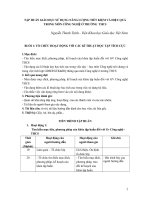Tài liệu dành cho Hacker
Bạn đang xem bản rút gọn của tài liệu. Xem và tải ngay bản đầy đủ của tài liệu tại đây (319.76 KB, 14 trang )
LESSON 8
DIGITAL FORENSICS
“License for Use” Information
The following lessons and workbooks are open and publicly available under the following
terms and conditions of ISECOM:
All works in the Hacker Highschool project are provided for non-commercial use with
elementary school students, junior high school students, and high school students whether in a
public institution, private institution, or a part of home-schooling. These materials may not be
reproduced for sale in any form. The provision of any class, course, training, or camp with
these materials for which a fee is charged is expressly forbidden without a license including
college classes, university classes, trade-school classes, summer or computer camps, and
similar. To purchase a license, visit the LICENSE section of the Hacker Highschool web page at
www.hackerhighschool.org/license.
The HHS Project is a learning tool and as with any learning tool, the instruction is the influence
of the instructor and not the tool. ISECOM cannot accept responsibility for how any
information herein is applied or abused.
The HHS Project is an open community effort and if you find value in this project, we do ask
you support us through the purchase of a license, a donation, or sponsorship.
All works copyright ISECOM, 2004.
2
LESSON 8 – DIGITAL FORENSICS
Table of Contents
“License for Use” Information..................................................................................................................2
Contributors................................................................................................................................................4
8.0 Introduction..........................................................................................................................................5
8.1 Forensic Principles................................................................................................................................6
8.1.0 Introduction...................................................................................................................................6
8.1.1 Avoid Contamination..................................................................................................................6
8.1.2 Act Methodically..........................................................................................................................6
8.1.3 Chain of Evidence.......................................................................................................................6
8.1.4 Conclusion.....................................................................................................................................6
8.2 Stand-alone Forensics.........................................................................................................................7
8.2.0 Introduction...................................................................................................................................7
8.2.1 Hard Drive and Storage Media Basics......................................................................................7
8.2.2 Encryption, Decryption and File Formats..................................................................................8
8.2.3 Finding a Needle in a Haystack...............................................................................................10
8.2.3.1 find.......................................................................................................................................10
8.2.3.2 grep.....................................................................................................................................10
8.2.3.3 strings...................................................................................................................................11
8.2.3.4 awk......................................................................................................................................11
8.2.3.5 The Pipe “|”.......................................................................................................................11
8.2.4 Making use of other sources.....................................................................................................11
8.3 Network Forensics..............................................................................................................................13
8.3.0 Introduction.................................................................................................................................13
8.3.1 Firewall Logs................................................................................................................................13
8.3.2 Mail Headers...............................................................................................................................13
Further Reading........................................................................................................................................14
3
LESSON 8 – DIGITAL FORENSICS
Contributors
Simon Biles, Computer Security Online Ltd.
Pete Herzog, ISECOM
Chuck Truett, ISECOM
Marta Barceló, ISECOM
Kim Truett, ISECOM
4
LESSON 8 – DIGITAL FORENSICS
8.0 Introduction
Forensics concerns the application of a methodical investigation technique in order to
reconstruct a sequence of events. Most people are now familiar with the concept of forensics
from TV and films, “CSI ( Crime Scene Investigation )” being one of the most popular. Forensic
science was for a long time – and still is really – most associated with Forensic Pathology –
finding out how people died. The first recorded description of forensics was on just this subject
In 1248, a Chinese book called Hsi DuanYu (the Washing Away of Wrongs) was published. This
book describes how to tell if someone has drowned or has been strangled.
1
Digital forensics is a bit less messy and a bit less well known. This is the art of recreating
what has happened in a digital device. In the past it was restricted to computers only, but
now encompasses all digital devices such as mobile phones, digital cameras, and even GPS
2
devices. It has been used to catch murderers, kidnappers, fraudsters, Mafia bosses and many
other decidedly unfriendly people.
In this lesson, we are going to cover two aspects of forensics (all computer based I'm
afraid – no mobile phone stuff here).
1. What people have been up to on their own computer.
This covers ...
• ... the recovery of deleted files.
• ... elementary decryption.
• ... searching for certain file types.
• ... searching for certain phrases.
• ... looking at interesting areas of the computer.
2. What a remote user has been doing on someone else's computer.
This covers ...
• ... reading log files.
• ... reconstructing actions.
• ... tracing the source.
This lesson is going to focus on the tools available under Linux. There are tools that are
available under Windows, as well as dedicated software and hardware for doing forensics,
but with the capability of Linux to mount and understand a large number of alternate
operating and file systems, it is the ideal environment for most forensic operations.
1 Apparently it is something to do with marks left around the throat, and the level of water penetration
into the lungs.
2 Global Positioning System – a thing which tell you where you are in the world using a number of
orbiting satellites.
5
LESSON 8 – DIGITAL FORENSICS









